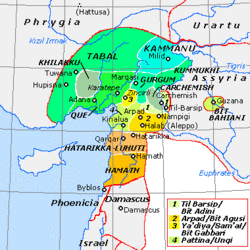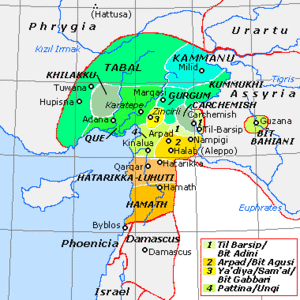
Assyria, also at times called the Assyrian Empire, was a Mesopotamian kingdom and empire of the Ancient Near East that existed as a state from perhaps as early as the 25th century BC until its collapse between 612 BC and 605 BC; thereby spanning the periods of the Early to Middle Bronze Age through to the late Iron Age. This vast span of time is divided into the Early Period, Old Assyrian Empire, Middle Assyrian Empire and Neo-Assyrian Empire. A Semitic-speaking realm, Assyria was centred on the Tigris River in Upper Mesopotamia, a region which covered, in modern terms, northern Iraq, northeast Syria, and southeast Turkey, with fringe areas of northwest Iran.
This article concerns the period 719 BC – 710 BC.

Sargon II was the king of the Neo-Assyrian Empire from the downfall of his predecessor Shalmaneser V in 722 BC to his death in battle in 705 BC. Though Sargon claimed to be the son of the previous king Tiglath-Pileser III, this is uncertain and he probably gained the throne through usurping it from Shalmaneser V. Sargon is recognized as one of the most important Neo-Assyrian kings due to his role in founding the Sargonid dynasty, which would rule the Neo-Assyrian Empire until its fall less than a century after Sargon's death.

The Hattians were an ancient Bronze Age people, that inhabited the land of Hatti, in central Anatolia. They spoke a distinctive Hattian language, that was neither Semitic nor Indo-European. Hattians are attested by archeological records from the Early Bronze Age, and also by historical references in later Hittite and other sources. Their main center was the city of Hattush. Faced with Hittite expansion, Hattians were gradually absorbed into the new political and social order, imposed by the Hittites, who were one of the Indo-European-speaking Anatolian peoples. The Hittites kept the country name unchanged, which also became the main designation for the Hittite state.
The short chronology is one of the chronologies of the Near Eastern Bronze and Early Iron Age, which fixes the reign of Hammurabi to 1728–1686 BC and the sack of Babylon to 1531 BC.

The Mushki were an Iron Age people of Anatolia who appear in sources from Assyria but not from the Hittites. Several authors have connected them with the Moschoi (Μόσχοι) of Greek sources and the Georgian tribe of the Meskhi. Josephus Flavius identified the Moschoi with the Biblical Meshech. Two different groups are called Muški in Assyrian sources, one from the 12th to the 9th centuries BCE near the confluence of the Arsanias and the Euphrates and the other from the 8th to the 7th centuries BCE in Cappadocia and Cilicia. Assyrian sources clearly identify the Western Mushki with the Phrygians, but later Greek sources then distinguish between the Phrygians and the Moschoi.

Tukulti-Ninurta I was a king of Assyria during the Middle Assyrian Empire. He is known as the first king to use the title "King of Kings".
Kizzuwatna, is the name of an ancient Anatolian kingdom in the 2nd millennium BC. It was situated in the highlands of southeastern Anatolia, near the Gulf of İskenderun, in modern-day Turkey. It encircled the Taurus Mountains and the Ceyhan River. The centre of the kingdom was the city of Kummanni, in the highlands. In a later era, the same region was known as Cilicia.
Isuwa was the ancient Hittite name for one of its neighboring Anatolian kingdoms to the east, in an area which later became the Luwian Neo-Hittite state of Kammanu.

The (pre)history of Mesopotamia ranges from the earliest human occupation in the Paleolithic period up to the Late antiquity. This history is pieced together from evidence retrieved from archaeological excavations and, after the introduction of writing in the late 4th millennium BC, an increasing amount of historical sources. While in the Paleolithic and early Neolithic periods only parts of Upper Mesopotamia were occupied, the southern alluvium was settled during the late Neolithic period. Mesopotamia has been home to many of the oldest major civilizations, entering history from the Early Bronze Age, for which reason it is often dubbed the cradle of civilization.
Nairi was the Akkadian name for a confederation of tribes in the Armenian Highlands, roughly corresponding to the modern Van and Hakkâri provinces of modern Turkey. The word is also used to describe the Armenian tribes who lived there. Nairi has sometimes been equated with Nihriya, known from Mesopotamian, Hittite, and Urartian sources. However, its co-occurrence with Nihriya within a single text may argue against this.

The Neo-Assyrian Empire was an Iron Age Mesopotamian empire, in existence between 911 and 609 BC, and became the largest empire of the world up until that time. The Assyrians perfected early techniques of imperial rule, many of which became standard in later empires. The Assyrians were the first to be armed with iron weapons, and their troops employed advanced, effective military tactics.

The Old Assyrian Empire (Sumero-Akkadian cuneiform: 𒆳𒀭𒊹𒆠 KUR AN-ŠAR2KI, Assyrian cuneiform: mat aš-šur KI, "Country of the city of god Aššur"; also phonetically mat da-šur) is the second of four periods into which the history of Assyria is divided, the other three being the Early Assyrian Period (2600–2025 BC), the Middle Assyrian Empire (1392–934 BC), and the Neo-Assyrian Empire (911–609 BC). Assyria was a major Mesopotamian East Semitic-speaking kingdom and empire of the ancient Near East. Centered on the Tigris–Euphrates river system in Upper Mesopotamia, the Assyrian people came to rule powerful empires at several times. Making up a substantial part of the "cradle of civilization", which included Sumer, the Akkadian Empire, and Babylonia, Assyria was at the height of technological, scientific and cultural achievements at its peak.

The Middle Assyrian Empire is the period in the history of Assyria between the fall of the Old Assyrian Empire in the 14th century BC and the establishment of the Neo-Assyrian Empire in the 10th century BC.

The ancient Near East was the home of early civilizations within a region roughly corresponding to the modern Middle East: Mesopotamia, ancient Egypt, ancient Iran, Anatolia/Asia Minor and the Armenian Highlands, the Levant, Cyprus and the Arabian Peninsula. The ancient Near East is studied in the fields of Ancient Near East studies, Near Eastern archaeology and ancient history.

Kummuh was an Iron Age Neo-Hittite kingdom located on the west bank of the Upper Euphrates within the eastern loop of the river between Melid and Carchemish. Assyrian sources refer to both the land and its capital city by the same name. The city is identified with the classical-period Samosata, which has now been flooded under the waters of a newly built dam. Urartian sources refer to it as Kummaha. The name is also attested in at least one local royal inscription dating to the 8th century BCE. Other places that are mentioned in historical sources as lying within Kummuh are lands of Kištan and Halpi, and cities of Wita, Halpa, Parala, Sukiti and Sarita(?). Kummuh bordered the kingdoms of Melid to the north, Gurgum to the west and Carchemish to the south, while to the east it faced Assyria and later Urartu.

The prehistory of Anatolia stretches from the Paleolithic era through to the appearance of classical civilisation in the middle of the 1st millennium BC. It is generally regarded as being divided into three ages reflecting the dominant materials used for the making of domestic implements and weapons: Stone Age, Bronze Age and Iron Age. The term Copper Age (Chalcolithic) is used to denote the period straddling the stone and Bronze Ages.
The Annals of Sargon II are a series of cuneiform inscriptions detailing the military actions of the Assyrian ruler Sargon II between 720 BCE and 705 BCE.

The timeline of the Assyrian Empire can be broken down into three eras: Old Assyrian Empire, Middle Assyrian Empire, and Neo-Assyrian Empire.

Tuwana was an Iron Age Luwian kingdom in southern Anatolia, one of the Syro-Hittite states, which existed in southeastern Anatolia in the 8th century BC.













